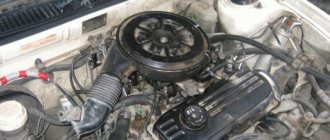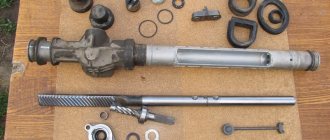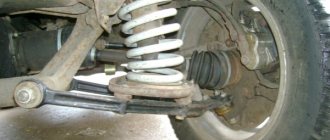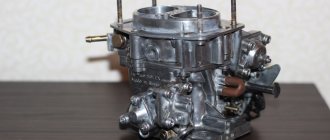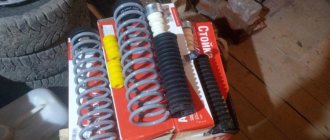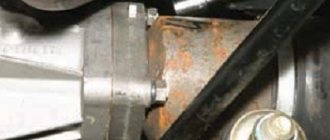Carburetor 2106
The standard option used on the Six engine is the “Ozone” sample. This is a two-chamber carburetor, with a falling air flow, emulsion type. The technical characteristics of the engine, when running, produced 75 horsepower, and the maximum speed was 155 km/h. Acceleration time to hundreds is 16 seconds.
The engine response is good, but when you press the gas pedal sharply, the car first chokes and then starts to move. This was explained by the fact that in the Ozone float chamber, the fuel level was insufficient, and during sharp acceleration there was not enough of it.
VAZ 2106 car owners were racking their brains over the question of which carburetor is better to install so that the engine's throttle response increases, while having minimal losses. Most opinions agreed that installing a Solex with a VAZ 21083 would be the best option.
Carburetor VAZ 2106
The VAZ “six” was produced by the Volzhsky Automobile Plant for 30 years, from 1976 to 2006. The car was equipped with carburetor engines with a volume of 1.3 liters to 1.6 liters. Various carburetors were used as part of the fuel system, but the most common was Ozone.
One of the most common carburetors for the VAZ 2106 was Ozone
What is it for?
For any carburetor engine, an integral component is the carburetor, which is designed to prepare the optimal composition of the fuel-air mixture by mixing air and fuel, as well as to supply this mixture to the cylinders of the power unit. For more efficient fuel combustion, mixing with air must occur in certain proportions, usually 14.7:1 (air/gasoline). Depending on the engine operating mode, the ratio may vary.
Carburetor design
Whatever carburetor is installed on the VAZ 2106, the differences between them are minimal. The main systems of the node in question are:
- idle system;
- float chamber;
- econostat;
- accelerator pump;
- transition system;
- starting system.
Ozone carburetor diagram: 1. Accelerator pump screw. 2. Plug. 3. Fuel jet of the transition system of the second chamber of the carburetor. 4. Air jet of the transition system of the second chamber. 5. Econostat air jet. 6. Econostat fuel jet. 7. Air jet of the main metering system of the second chamber of the carburetor. 8. Econostat emulsion jet. 9. Diaphragm mechanism for pneumatic drive of the throttle valve of the second chamber of the carburetor. 10. Small diffuser. 11. Jets for the pneumatic drive of the throttle valve of the second chamber of the carburetor. 12. Screw—valve (discharge) of the accelerator pump. 13. Acceleration pump nozzle. 14. Carburetor air damper. 15. Air jet of the main metering system of the first chamber of the carburetor. 16. Damper jet of the starting device. 17. Diaphragm trigger mechanism. 18. Air jet of the idle system. 19. Fuel jet for idle system.20. Fuel needle valve.21. Carburetor strainer. 22. Fuel fitting. 23. Float. 24. Idle speed adjustment screw. 25. Fuel nozzle of the main metering system of the first chamber.26. Screw for the “quality” of the fuel mixture. 27. Fuel mixture “amount” screw. 28. Throttle valve of the first chamber. 29. Thermal insulation spacer. 30. Throttle valve of the second chamber of the carburetor. 31. Diaphragm rod of the pneumatic drive of the throttle valve of the second chamber. 32. Emulsion tube. 33. Fuel nozzle of the main metering system of the second chamber. 34. Accelerator pump bypass jet. 35. Accelerator pump suction valve. 36. Accelerator pump drive lever
To better understand the operation of the device, the listed systems should be considered in more detail.
Idle system
The idle speed system (IAC) is designed to maintain stable engine speed when the throttle valve is closed. In this operating mode, the engine receives power without external assistance. Fuel is taken by the system from the float chamber and mixed with air in the emulsion tube.
Diagram of the carburetor idle system: 1 - throttle body; 2 — throttle valve of the primary chamber; 3 - holes for transition modes; 4 - hole, adjustable with a screw; 5 — air supply channel; 6 — mixture quantity adjustment screw; 7 — adjusting screw for the composition (quality) of the mixture; 8 — emulsion channel of the idle system; 9 — additional air adjusting screw; 10 — carburetor body cover; 11 — air jet of the idle system; 12 — fuel jet of the idle system; 13 — fuel channel of the idle system; 14 - emulsion well
Float chamber
The design of any carburetor includes a float chamber in which a float is located that controls the fuel level. Despite the simplicity of this system, there are times when the fuel level does not correspond to the optimal value. This is due to a violation of the tightness of the needle valve. The reason for this phenomenon is the operation of the car on low quality fuel. The problem is eliminated by cleaning or replacing the valve. The float itself needs adjustment from time to time.
There is a float in the float chamber of the carburetor that controls the fuel level
Econostat
The econostat provides the engine with fuel when operating at high speeds and supplies the fuel-air mixture in proportions corresponding to the speed. By its design, the econostat consists of a tube with different sections and emulsion channels, which are located at the top of the mixing chamber. At maximum engine loads, a vacuum occurs in this place.
Acceleration pump
To prevent failure when you press the gas pedal sharply, the carburetor is equipped with an accelerator pump, which supplies additional fuel. The need for this mechanism is due to the fact that during sudden acceleration the carburetor is not able to supply the required amount of fuel to the cylinders.
Accelerator pump diagram: 1 - valve-screw; 2 - sprayer; 3 - fuel channel; 4 — bypass jet; 5 - float chamber; 6 — accelerator pump drive cam; 7 — drive lever; 8 — return spring; 9 — diaphragm cup; 10 — pump diaphragm; 11 — inlet ball valve; 12 — gasoline vapor chamber
Transition system
Transition systems in the carburetor enrich the fuel mixture during the transition from idle to the operation of the main metering systems, when the accelerator pedal is smoothly pressed. The fact is that when the throttle valve is opened, the amount of air passing through the diffuser of the main dosing system increases. Although a vacuum is created, it is not enough to drain fuel from the nozzle of the main metering chamber. The combustible mixture becomes leaner due to the large amount of air in it. As a result, the engine may stall. The situation with the second chamber is similar - when opening the throttle valve, it is necessary to enrich the fuel mixture to prevent dips.
Starting system
When starting a cold carburetor engine, it is not always possible to ensure the supply of the required amount of fuel and air. To do this, the carburetor has a starting system that allows you to regulate the air supply using an air damper. This part is located on the first chamber and is adjusted with a cable from the interior. As the engine warms up, the throttle opens.
Choke is a device that covers the inlet for supplying air to the carburetor when starting the engine when cold.
Diaphragm trigger diagram: 1 - air damper drive lever; 2 - air damper; 3 — air pipe of the primary chamber of the carburetor; 4 - traction; 5 — starting rod; 6 — diaphragm of the starting device; 7 — adjusting screw of the starting device; 8 - cavity communicating with the throttle space; 9 — telescopic rod; 10 — damper control lever; 11 — lever; 12 — axis of the throttle valve of the primary chamber; 13 — lever on the axis of the primary chamber damper; 14 — lever; 15 — axis of the throttle valve of the secondary chamber; 1 6 — throttle valve of the secondary chamber; 17 — throttle body; 18 — throttle control lever of the secondary chamber; 19 — thrust; 20 - pneumatic drive
When the choke handle is pulled out, the mixture is enriched, but a gap of 0.7 mm remains so as not to flood the spark plugs.
What carburetors are installed on the VAZ 2106
Despite the fact that the VAZ “six” has not been produced for a long time, a large number of these cars are found on the roads. Their owners often wonder which carburetor can be installed instead of the standard one, with the following goals being pursued: to reduce fuel consumption, improve the dynamic performance of the car and generally achieve optimal performance characteristics. It is quite possible to realize these desires today, for which purpose the standard carburetor is replaced. Let's consider what modifications of the devices in question can be installed on the VAZ 2106.
DAAZ
At the beginning of the production of cars of the VAZ family, the power units were paired with carburetors of the Dmitrov Automotive Aggregate Plant (DAAZ). To manufacture these units, a license was purchased from Weber. Many “sixes” still have exactly these carburetors today. They are characterized by good dynamics, simple design and high fuel consumption, usually at least 10 liters per 100 km. It is very difficult to purchase such a carburetor in good condition. To assemble a normally functioning unit, you will need to purchase several devices.
Initially, the VAZ 2106 was equipped with a DAAZ carburetor, which provided good dynamics, but also had high fuel consumption
Find out more about the DAAZ carburetor: https://bumper.guru/klassicheskie-modeli-vaz/toplivnaya-sistema/karbyurator-daaz-2107–1107010-ustroystvo-i-regulirovka.html
Ozone
The Ozone carburetor was created on the basis of Weber, but the unit had distinctive features:
- fuel efficiency;
- reduction of exhaust gas toxicity.
In those days, this carburetor was considered the most environmentally friendly. If the device is adjusted correctly, then the dynamics should be good, and fuel consumption should be 7–10 liters per 100 km. Despite its positive qualities, the knot also has disadvantages. The fact is that the secondary chamber is opened using a pneumatic drive, which sometimes refuses to work. In addition, problems arise with the forced idle system due to wear on the diaphragm.
The Ozone carburetor was more economical and environmentally friendly compared to the DAAZ
If the adjustments are violated or the mechanism is dirty, the secondary chamber may not open at all or open, but with a long delay. As a result, the dynamics deteriorate, stable engine operation at medium and high speeds is disrupted. In order for the Ozone carburetor to operate smoothly, the unit must be periodically serviced.
More information about the Ozone carburetor: https://bumper.guru/klassicheskie-modeli-vaz/toplivnaya-sistema/karbyurator-ozon-2107-ustroystvo.html
Solex
DAAZ-21053 carburetors (Solex) are especially popular among Zhiguli owners. The device has good dynamics and efficiency indicators. For the “six” this is one of the best options. Compared to previous carburetors, Solex has design differences, since it is equipped with a fuel return system: it supplies fuel back to the fuel tank. As a result, it is possible to save about 400–800 g of gasoline per 100 km.
Some Solex modifications were equipped with an idle speed control valve and an automatic cold start system.
The Solex carburetor has good dynamics and fuel efficiency
The operation of such a carburetor showed that the device is quite capricious due to narrow fuel and air channels, which often become clogged. As a result, problems with idle speed arise, and later other problems. Fuel consumption is 6–10 liters per hundred with measured driving. In terms of dynamics, the Solex is second only to the Weber of the first years of production. In order for this carburetor to work flawlessly, it is necessary to carry out preventive maintenance in a timely manner.
Find out more about Solex: https://bumper.guru/klassicheskie-modeli-vaz/toplivnaya-sistema/karbyurator-soleks-21073-ustroystvo.html
Installing two carburetors
The owners of Zhiguli cars, who are not satisfied with the operation of the engine at high speeds, are thinking about installing two units for mixing fuel and air. The fact is that the channels of a standard intake manifold have different lengths, and this does not allow the engine to develop full power. The introduction of two carburetors ensures a more uniform supply of the fuel-air mixture, which increases torque and increases the power of the power unit.
If you are interested in upgrading your six, you need to know that you can do this kind of work yourself. To carry it out you will need patience, the necessary materials and components. Installing two carburetors requires the following list:
- two intake manifolds from an Oka car;
- tees for the fuel system;
- throttle valve drive parts;
- set of hoses and tees;
- a strip of metal 3–4 mm thick.
When installing two carburetors, a more uniform supply of the fuel-air mixture into the combustion chamber of the engine is ensured.
In addition to the above, you need to prepare a set of standard tools (screwdrivers, wrenches, pliers), as well as a vice, drill and metal cutter. As for the choice of carburetor, you need to install two identical models, for example, Ozone or Solex. The installation process begins with removing the standard intake manifold and adjusting the Oka parts so that they fit neatly to the cylinder head.
For ease of work, it is recommended to remove the block head.
When preparing intake manifolds, close attention is paid to the channels: the surface should not have any protruding elements. Otherwise, the mixture flow will experience resistance while the engine is running. All interfering parts must be removed using a cutter. Having completed all the preparatory procedures, the carburetors are installed. Then the devices are adjusted by unscrewing the quality and quantity screws by the same number of turns. In order for both devices to open at the same time, it is necessary to make a bracket that will connect to the gas pedal. A suitable cable, for example, from a Tavria car, is used as a drive for carburetors.
Carburetor VAZ 21083
The VAZ 21083 car was equipped with a Solex carburetor. Just like Ozone, it was intended for 1500 cc engines. Its float (primary) and secondary chambers were slightly enlarged, and the fuel level was correspondingly higher. Solex provided the Eight with the following technical indicators: power - 70 hp, rated speed - 155 km/h. At the same time, acceleration to 100 km/h took 15 seconds.
The characteristics are not particularly better than those of the VAZ 2106. But this is explained by a different engine structure. And here’s what the “Six” will show us, when equipped with this carburetor.
Installation procedure
The Solex carburetor is absolutely suitable for mounting on the VAZ 2106 engine. Since the device itself is different, you will need to purchase some additional parts in order for the installation to be successful and the engine to work properly. The parts list includes the following items:
- 2 paronite gaskets and 1 paper;
- 1 meter of hose for fuel supply;
- Carburetor, always with a slide;
- A set of keys, screwdrivers and other locksmith supplies.
Now, you can get to work. Before installing the Solex on a VAZ 2106, clean the area where the Ozone carburetor connects to the engine. This is done so that when removing, debris does not get into the engine. Next, disconnect all the hoses and cables.
Next, unscrew the fastenings and remove the “Ozone” from the engine. Before installing the carburetor from the VAZ 21083, clean the mounting location. Afterwards, apply sealant and lay the gasket. The gaskets should be in this order: thin, thick and thin.
When the seat is ready, disassemble the Solex into two parts. This will make it easier for you to install it. First of all, install the rocker from the carburetor VAZ 21083 to 2106, as this is the key element required to begin the installation. You can already install the Solex on it.
Now, connect all the cables and hoses. We start with the throttle cable. It must be set to the required length, which is enough to connect it. Next in line is the fuel system hose. Before installing it, it is worth considering that on the VAZ 21083 it is longer than on the 2106, so you will need a pre-prepared meter hose. Place one of its tips on the outlet of the fuel system, and the second on the inlet to the carburetor. Before putting on the second end, it is better to cut it so that it does not dangle freely in the engine compartment. Also, remember, the longer the hose, the more fuel it will contain, and therefore the weight. This can cause it to become disconnected and possibly even cause the engine to catch fire.
Connecting and setting up the rods
Next, we connect one end of the return flow to the fine filter, do not forget to install a valve in it. Place the other end on the carburetor. We put all the springs in their places (they do not need to be replaced with new ones). Once all the hoses and cables are in place, you will need to worry about the idle speed. To do this, install a solenoid valve.
The final touch is to put on the top part of the carburetor and tighten the fastening nuts. Now, your Solex is ready for use.
Settings
Before you start operating the carburetor from a VAZ 21083 on a VAZ 2106, it must be configured.
In order for the mixture to be prepared better and for you to make adjustments easier, park the car on level ground, without slopes. Start the engine and test it at high and low speeds. This will let you know in which mode the engine receives a normal mixture, and in which it requires adjustment.
After running the engine for a while on the new carburetor and filling its chambers with gasoline, you will need to check what a constant level is in them. To do this, remove the cover from the carburetor, and using a caliper, measure the distance from the fuel level to the top edge of the float chamber. It is best if the level is from 23 to 25 mm. In this case, the carburetor will not flood the spark plugs and stall at idle.
To adjust the fuel level, simply bend the float in the desired direction (up or down). After each change in position, check the resulting distance. When the float is set, assemble the device and begin adjusting the quality and quantity of fuel.
On a VAZ 21083, the correct mixture is obtained with the following settings:
- Quantity screw: 1.5 – 2 turns;
- Quality screw: 4 – 4.5 turns.
After installing it on the VAZ 2106, it is necessary to configure the device after the engine has run at all speeds. And also, the fuel must be heated to operating temperature.
After installation, the characteristics of the Six engine will acquire several pros and cons.
The advantages are that the engine will be more responsive, the maximum speed will increase (up to 160 -165 km/h), and the acceleration time to the first hundred will be reduced (instead of 15 seconds - 13). The modernization will not significantly affect the rated power, increasing it by 5 - 10 hp.
The only downside is fuel consumption. With normal, non-economical driving in the urban cycle, it will increase by 1 - 1.5 liters.
The general conclusion is this: installing this carburetor is a necessary thing, because for the price of 1 - 1.5 liters per 100 kilometers, you will get more driving comfort.
Carburetor adjustment
Tuning the VAZ 2106 carburetor is not a delicate matter. Basically, all advanced car owners replace their original carburetor with Solex or Ozone, their design is very similar, as is the adjustment. You shouldn’t just get into the carburetor, because if everything works fine, then you don’t need to touch anything. However, if the following signs of malfunction occur, you will have to study the device and climb inside:
- Dips when accelerating the car (after pressing the pedal, the car does not accelerate, or accelerates very slowly).
- Car jerks when accelerating.
- Very slow acceleration, albeit smooth.
- Cascading dips during prolonged acceleration.
Carburetor Ozone
Adjusting the fuel level
Adjusting the fuel level is where carburetor adjustment begins. On Solex and Ozone carburetors this process is practically identical, so that it will help the user of both types. First, warm up the engine a little; you can carry out this operation after the trip. We start by disconnecting the fuel line hose; this must be done carefully so that the hot fuel does not burn you. Next, we remove the top cover of the carburetor (after first freeing the carburetor from the air filter “pan” covering it. Then we disconnect the cable of the choke lever and carefully remove the cover, this must be done so as not to damage the floats. Now we arm ourselves with a ruler, preferably, in fact, a caliper , but a ruler will do. You need to measure the distance from the top edge of the gasoline to the cap, it should correspond to about 24 mm. The fuel level in the chambers may vary, since the carburetor is very rarely located perfectly horizontally, so you need to take the average result. If the result is outside installed frame.Then the adjustment on the Solex carburetor comes down to the fact that you just need to bend the float holders in the desired direction.
Idle speed adjustment
The Solex device is such that all adjustments can be made absolutely easily with just instructions. Adjusting the idle speed comes down to turning the screw with a screwdriver. First, we find the hole with this screw; it is located at the bottom of the Solex carburetor, next to one of the holes for attaching the carburetor to the manifold. Now we tighten the adjusting screw until it stops and unscrew it back 5 turns of the screwdriver. Next, start the engine and completely remove the choke. Now you need to rotate the screw to set the idle speed to the minimum value at which the engine will operate stably. If the tachometer shows a number of about 850 rpm, this will mean that the Solex is functioning quite properly.
Selection of jets for Solex
The Solex carburetor provides that the jets can be replaced after their service life has expired or at the request of the owner, for example, due to the need to adjust the efficiency of the car. Jets allow you to change the dosage of incoming fuel or air. With their help, you can easily achieve stable engine operation or increase its efficiency. Jets are selected according to special tables, taking into account engine power; these tables can be found on the Internet or in books dedicated to the car.
What to put?
Sometimes there is a need to completely replace the carburetor. Therefore, you immediately need to decide which model to buy. Today there are two most common families: Solex and Ozone carburetors.
Many car owners don’t even know what kind of device they have. Externally, these devices can be distinguished by the following characteristics.
- In Ozone, the fuel intake fitting has the shape of an oblong tube, in Solex it is a return
- Ozone consists of three parts: the throttle valve axis, the float chamber and the cover. Solex consists of only two parts: the lower part with the float chamber and the upper part - the cover in which the float is held.
- The ozone has a vacuum valve that controls the opening of the throttle valve of the second chamber.
- On a Solex carburetor, the air damper is controlled by such a large lever: On ozone, this lever looks completely different. It is also called a three-arm lever.
In the 90s, a massive hobby began to replace the standard Ozone with Solex. Taxi drivers were especially guilty of this. This was explained by the fact that fuel consumption decreased slightly, and engine dynamics became a little better.
If you install an oxygen sensor and compare its values on different models, you can understand the reason for this phenomenon. With Solex, after adjusting the mixture composition, the range in composition is no more than one. On ozone, after adjusting the mixture at the moments of braking and acceleration, the mixture acquires a very strong spread of values. At the same time, it can increase or decrease by a large value.
This is due to the fact that the jets on the Solex are located in the center of the float chamber. When the position of the car changes during sharp turns or during acceleration and braking, part of the fuel is deflected by inertia towards one of the walls of the float chamber. The central location of the jets reduces the likelihood of changes in the fuel composition at these moments.
On ozone, the device is significantly different. The jets are not in the center. Therefore, fuel moves around the float chamber in different directions, which significantly changes the spread of air proportions in the fuel mixture. In different driving modes, the engine receives a different mixture composition.
So, the Solex carburetor on the VAZ 2106 keeps the mixture more stable while driving. This is its main technical advantage.
Which carburetor is better to install on a VAZ 2106: removal and installation
At the factory, the six, as a rule, was equipped with an outdated model of Ozone-type carburetors. This is a Daaz carburetor, which was also widely installed on the seven. And although some models already worked with the Solex family in the standard version, this was still rare. You may have asked questions:
- Which carburetor is better to install on a VAZ 2106?
- How to install a carburetor on a VAZ 2106?
Let's discuss this.
What to put?
Sometimes there is a need to completely replace the carburetor. Therefore, you immediately need to decide which model to buy. Today there are two most common families: Solex and Ozone carburetors.
Many car owners don’t even know what kind of device they have. Externally, these devices can be distinguished by the following characteristics.
- In Ozone, the fuel intake fitting has the shape of an oblong tube, in Solex it is a return
- Ozone consists of three parts: the throttle valve axis, the float chamber and the cover. Solex consists of only two parts: the lower part with the float chamber and the upper part - the cover in which the float is held.
- The ozone has a vacuum valve that controls the opening of the throttle valve of the second chamber.
- On a Solex carburetor, the air damper is controlled by such a large lever: On ozone, this lever looks completely different. It is also called a three-arm lever.
In the 90s, a massive hobby began to replace the standard Ozone with Solex. Taxi drivers were especially guilty of this. This was explained by the fact that fuel consumption decreased slightly, and engine dynamics became a little better.
If you install an oxygen sensor and compare its values on different models, you can understand the reason for this phenomenon. With Solex, after adjusting the mixture composition, the range in composition is no more than one. On ozone, after adjusting the mixture at the moments of braking and acceleration, the mixture acquires a very strong spread of values. At the same time, it can increase or decrease by a large value.
This is due to the fact that the jets on the Solex are located in the center of the float chamber. When the position of the car changes during sharp turns or during acceleration and braking, part of the fuel is deflected by inertia towards one of the walls of the float chamber. The central location of the jets reduces the likelihood of changes in the fuel composition at these moments.
On ozone, the device is significantly different. The jets are not in the center. Therefore, fuel moves around the float chamber in different directions, which significantly changes the spread of air proportions in the fuel mixture. In different driving modes, the engine receives a different mixture composition.
So, the Solex carburetor on the VAZ 2106 keeps the mixture more stable while driving. This is its main technical advantage.
Removing and installing the carburetor
- We remove the hose that takes warm air from the pipe. To do this, you will need to first loosen the clamp.
- Remove the air filter.
- Cover the carburetor with a clean, lint-free cloth. This is necessary so as not to accidentally drop the filter housing mounting nuts into the float chamber.
- Unscrew these nuts.
- We remove the plate.
- Remove the hose from the crankcase.
- Remove the filter housing.
- Remove the fuel hose.
- Remove the tip of the solenoid valve.
- Unscrew the bolt that secures the drive cable.
- Unscrew the cable screw.
- Carefully remove the cable.
- Remove the gas exhaust hose from the crankcase.
- Removing the ignition regulator hose
- We remove the spring.
- Unscrew the nuts securing the carburetor. You need to act very carefully, not to use too much force. The fact is that the mating plane of the device is made of soft metal and can easily be damaged.
- The carburetor can be removed from the engine.
Installation of a working device is carried out in reverse order according to the same scheme.
comments powered by HyperComments
You might be interested:
7vaz.ru
Removing and installing the carburetor
- We remove the hose that takes warm air from the pipe. To do this, you will need to first loosen the clamp.
- Remove the air filter.
- Cover the carburetor with a clean, lint-free cloth. This is necessary so as not to accidentally drop the filter housing mounting nuts into the float chamber.
- Unscrew these nuts.
- We remove the plate.
- Remove the hose from the crankcase.
- Remove the filter housing.
- Remove the fuel hose.
- Remove the tip of the solenoid valve.
- Unscrew the bolt that secures the drive cable.
- Unscrew the cable screw.
- Carefully remove the cable.
- Remove the gas exhaust hose from the crankcase.
- Removing the ignition regulator hose
- We remove the spring.
- Unscrew the nuts securing the carburetor. You need to act very carefully, not to use too much force. The fact is that the mating plane of the device is made of soft metal and can easily be damaged.
- The carburetor can be removed from the engine.
Installation of a working device is carried out in reverse order according to the same scheme.
This article is part of a series of 9 lessons dedicated to 7 carburetors. To view all nine lessons, follow the link: https://7vaz.ru/chto-takoe/karbyurator.html
Source: 7vaz.ru
Modernization of the VAZ-2106 car: installation and adjustment of the Solex carburetor
Initially, the VAZ-2106 car left the factory with an Ozone carburetor. However, this unit has so many shortcomings that with the advent of the more modern Solex carburetor, many owners of classic Zhiguli cars could not resist the opportunity to improve the engine of their car. Among most of them there was an opinion that this would improve the technical characteristics of the car, while others believed that this decision would have a detrimental effect on the stability of the engine. In this article we will look at what advantages such a modernization has and, if any, how to install and adjust the Solex carburetor on a VAZ-2106 car with your own hands.
With the “native” carburetor, the engine of the “sixth” model had good throttle response. But there was also a significant drawback in the form of failures when trying to sharply increase the crankshaft speed. That is, as soon as the driver pressed the gas pedal, the engine first “choked” and only then began to gain momentum. The reason for this is the insufficient fuel level in the float chamber, which affected during intensive acceleration of the car. That is why the owners of the “sixes” wondered about the possibility of installing an alternative carburetor that could increase the engine’s throttle response with minimal losses. The choice fell on the Solex unit as the best option.
Initially, the six was equipped with an OZONE carburetor
Features of Solex carburetors for VAZ-2106 cars
Often, car owners, in order to save fuel and improve dynamic characteristics, install Solex VAZ-21083 or 21073 carburetors on their cars, but these units do not always live up to expectations. As an alternative, the Dmitrovgrad Automotive Aggregate Plant specially developed model 21053-1107010-20, designed to work with 1.5 and 1.6 liter engines; today this carburetor is considered one of the best for VAZ classics. The main advantages that should be noted when installing a 21053-20 carburetor instead of the standard “Ozone”:
- vehicle dynamics are improved;
- it takes less time to warm up the internal combustion engine;
- ensures smooth running of the machine;
- When driving slowly, fuel is saved.
Also, Solex is easy to set up and not capricious, although it also has its drawbacks: you have to buy some spare parts (rods that fit from the Niva, an air filter housing, a thick gasket), and spend additional time on fitting and modification.
Installing a Solex carburetor on a VAZ six
Since the unit from the VAZ-21083 car was intended for an engine with the same volume (1500 cm 3), it was the one that was best suited as an alternative to the standard Ozone. Thanks to enlarged float chambers, a higher level of gasoline was provided. Paired with the V8 engine, it demonstrated not particularly outstanding characteristics compared to the VAZ-2106. However, he still managed to improve the model. Next, we will look at how to correctly install a Solex carburetor on a VAZ-2106, after which we will figure out how to adjust it.
The carburetor in question is not so difficult to install on a “six” engine, since its mountings are exactly the same as those of the original unit. However, its design itself is different, so you will have to purchase some parts before installation. For successful installation and normal operation of the engine, in addition to the carburetor itself, you will need:
- a set of gaskets - one paper and two paronite;
- fuel hose 1 meter long;
- standard set of wrenches and screwdrivers;
- sealant (can be purchased at any auto parts store).
Experienced motorists often replace problematic Ozone with the more reliable Solex
If you have prepared everything you need, you can begin installation, but before installing the Solex carburetor, make sure that there is no dirt or dust where it contacts the intake manifold. It is assumed that you have previously removed the old unit by unscrewing the fastening nuts and disconnecting all rods, wires and hoses. Clean the connection area thoroughly to prevent foreign objects from entering the motor and follow the instructions below:
- Apply a sealing compound to the contact area of the surfaces and place three gaskets so that one thick one is between two thin ones. After preparing the seat, you can begin installing the Solex carburetor on the VAZ-2106 engine, but before that it is better to disassemble it into two parts, which will significantly simplify the installation process.
- Now you can install the linkage of the throttle drive rods from the VAZ-21083, after which all that remains is to place the unit itself in its place, securing it with fastening nuts.
- Further steps involve connecting the cable and hoses. And you should start with the cable that controls the air damper. It must be set to a length sufficient for connection.
- After this, the turn comes to the fuel hose, which should be connected at one end to the fuel system, and the other end should be put on the carburetor inlet. It is better to adjust the length of the hose in advance so that it does not dangle in the engine compartment.
- As for the return fuel line, it must be connected to the fine filter through a check valve - this way it will be involved in the fuel supply circuit. There is another option that involves installing a simple plug in the fuel return fitting. But the first method is more preferable, since it eliminates the possibility of overloading the carburetor valve mechanism, which can cause problems in its operation.
- If the return issue is resolved, all that remains is to install the solenoid shut-off valve. After this, replace the top of the carburetor with a new gasket and secure it with nuts.
- The hoses of the vacuum regulator and heating system should be connected to the tee of the unit. After this, replace all the springs; they do not need to be replaced if they are in good condition. Reinstall the air filter housing and cover.
Which carburetor is better to install on a VAZ-2106: expert advice
Today on the roads you can often find cars that are 20 or even 30 years old. These are mainly classic VAZ models. The owners of these old cars do their best to keep them alive and strive for optimal performance. The owners of old Zhiguli cars want to improve the dynamics of the car and reduce fuel consumption. This can be done, but it all depends on the carburetor. Let's look at which carburetor is better to install on the VAZ-2106 to get the result. This task is quite feasible, despite the fact that the driver can replace the device and adjust it independently. If you look at the reviews of drivers who replaced the standard carburetor, the effect is quite noticeable.
A brief history of carburetors for VAZ
On the first classic VAZ models, which were an improved Italian Fiat, devices manufactured by the Dmitrov Automotive Aggregate Plant were installed in the power supply system in conjunction with the motors. For the production of these carburetors, a license was purchased from the French. These mechanisms were assigned the index DAAZ-2106 for the VAZ “Six” model. Until now, such carburetors are popularly called “DAAZ” and “Weber”. Many car owners still actively use them. The use of these mechanisms gives good dynamic characteristics. These carburetors have a simple design without unnecessary design features. But “Webers” have one very significant drawback - they have huge appetites. These models have not been produced for a long time, since along with the VAZ-2105 model, all other Zhigulis were equipped with Ozon products. Below we will talk about it in more detail.
"Ozone"
The Ozone carburetor on the VAZ-2106 is a completely domestic development by Dmitrov engineers. It differs significantly from French mechanisms both in design and performance characteristics. “Ozone” (carburetor) received this name for a reason - at that time it was considered the most environmentally friendly. Owners speak positively about these devices. But sometimes various problems happen to them too. For the VAZ-2106, its price is from four thousand rubles.
"Ozone" and its problems
Sometimes the pneumatic drive of the damper on the secondary chamber refuses to work normally. Troubles also arise with a worn out diaphragm in the forced idle economizer system. If for some reason dirt gets into the mechanism or the adjustments are broken, then the second chamber may not open at all, or it may open, but with a serious delay. This leads to a significant decrease in dynamics. Power is lost, the maximum speed of the car decreases, the engine is unstable at high and medium speeds. Despite all this, the DAAZ-1107010 “Ozone” carburetor produces good dynamic characteristics with a fuel consumption of about seven liters per 100 kilometers. Naturally, the device must be constantly monitored and maintained. To avoid contaminating the internal chambers, it is recommended to periodically clean them. A special carburetor cleaner is used. This chemical is sold in aerosol cans.
"Solex"
These mechanisms are no less popular. DAAZ-21053 is especially popular. It is also manufactured under license. This carburetor has good dynamic characteristics and is also economical. This is a good solution if you need a carburetor for the “Six”. The design of the Solex is fundamentally different from all previous devices from the Dmitrov Automotive Unit, equipped with a fuel return supply system. With this solution, gasoline can be returned to the car's gas tank. By using a reverse fuel supply system, it is possible to save up to 400-800 grams of fuel per hundred kilometers. Some versions of Solex can be supplemented with auxiliary electronic systems. Among them is an idle system with the ability to adjust using an electric valve. Also found on export models. In the CIS countries, a model with an electric idle air valve was widespread. This two-chamber carburetor turned out to be quite difficult to operate. The channels are made narrow and often clogged. If the device is not maintained, then the idle system begins to malfunction first, and then all other components. In terms of fuel consumption, the Solex on the VAZ-2106 consumed from 6 to 10 liters when driving in quiet mode. In terms of dynamic characteristics, the unit is second only to the early Weber. If you do preventive carburetor repairs in a timely manner, Solex will not cause any special problems.
How to choose a carburetor and what to install on a VAZ-2106?
Those who like to make improvements to classic models from AvtoVAZ and simply owners who want to improve the performance characteristics of the car most often choose Solex. Models used are DAAZ-21083. Installing them on classic models is impossible without significant modifications. When thinking about which carburetor is best to install on a VAZ-2106, you need to take into account the engine size. For 1.3-liter units, the DAAZ-2018 option is perfect. For engines with a volume of 1.6 liters, the best choice is DAAZ-21083. The differences between these two models are in the cross-sectional diameter of the diffusers, as well as in the sizes of the fuel and air jets. If you install this carburetor as it is, then at speeds close to 4 thousand, the air emission speed can reach supersonic, which is not acceptable. But this will not affect acceleration in any way. It is necessary to enlarge the diffusers on the first and second chambers and install other jets. After this, fuel consumption will be the same as on 21053, and the dynamics will be better than on 21073. For VAZ-2106 cars, the price of such a carburetor will be about five thousand rubles.
Features of the installation DAAZ-2108, -21083
To install any of these models on the “Classic”, it is necessary to prepare a new set of gaskets, hoses for the carburetor heating system, a tee for connecting to the fuel system, a valve and rods for the accelerator. To get the maximum result from this procedure, it is advisable to replace the ignition. It is better to install a more technologically advanced, electronic one. Contact ignition is a thing of the past. The system is very unreliable and often causes operational problems. The installation of contactless electronic ignition is one of the most useful improvements for domestic VAZs, in particular for the Six.
"Solex-21053"
This model has fewer problems and does not require serious tuning, since this carburetor is modernized for classic models. These units work well with 1.5 and 1.6 liter engines. This is an excellent choice for those who would like to get more dynamics from their car.
Other options
But don’t think that this is all that is suitable for “Classics”. If you think about which carburetor is better to install on a VAZ-2106, then you also remember the Solex-21073. It is designed for 1.7 liter engines - from 21053 it is distinguished by larger channels and enlarged jets.
After installing it, you can get even more dynamics, and the fuel consumption will be 9-12 liters. And if you are not afraid of the consumption and rare preventative repairs of the Solex carburetor, then you can opt for it.
Bottom line
Of course, these are not all carburetor models that can be installed specifically on the VAZ-2106 and other classic Zhiguli cars. There are a lot of Chinese devices, as well as devices from European and American manufacturers. Both single- and double-chamber models are available for sale. But they are expensive and do not always guarantee high dynamic performance and efficiency. You will only get one of the two. Therefore, the question of which carburetor is better to install on a VAZ-2106 can be answered this way: it is best to install a domestic device, one of the above. Reviews from motorists recommend installing “Ozone”. It is one of those that, with low fuel consumption, produces maximum dynamics for a car.
fb.ru
How to adjust a Solex carburetor
Only a properly adjusted carburetor can ensure maximum engine performance and efficiency. For the most accurate adjustment, experts recommend installing the car on a level surface - this promotes better preparation of the air-fuel mixture. First, start the engine and test its operation at different speeds. This way, you can determine in which mode the normal mixture is prepared, and in which adjustment is required.
The following guide will tell you how to set up a Solex carburetor on a VAZ-2106:
- Once you have started the engine, let it run to warm up to operating temperature.
- During warm-up, the float chambers will fill with fuel, which will allow you to check its level. To do this, you need to remove the cover from the carburetor and measure the distance between the upper edge of the float chamber and the level of gasoline in it. Use a caliper. The recommended level at which the spark plugs will not flood and the engine will not stall at idle is 23–25 mm. If the obtained values do not correspond to the norm, you will have to adjust the carburetor regarding the fuel level.
- Adjustment of the gasoline level in the float chambers is carried out by bending/bending the float up or down.
- Once the setup and control measurements are complete, replace the cover and proceed to the next step.
- Next, adjusting the Solex carburetor on the VAZ-2106 consists of adjusting the idle system. If you purchased a new unit for installation, then the optimal settings for preparing a combustible mixture at idle speed are as follows:
- The mixture quantity screw must be unscrewed 1.5–2 turns;
- The mixture quality screw should be unscrewed 4–4.5 turns.
This concludes the guide on how to adjust the Solex carburetor on a VAZ-2106 after installing it. However, in conclusion, it should be said that the “sixth” model with this unit will inherit both important advantages and noticeable disadvantages. The first includes improved engine response and a top speed increased to 165 km/h. The modernization also has a positive effect on acceleration - the car will be able to reach the first 100 km/h two seconds faster. As for the disadvantages, there are only two of them - increased fuel consumption and increased requirements for the quality of gasoline use. In general, by installing a Solex carburetor on a VAZ-2106 with your own hands, you will get more comfortable driving, the cost of which is not so high.
Source: carextra.ru
What are the jets responsible for?
This is the name given to carburetor parts that have calibration holes for dosing fuel or air. As you may have guessed, depending on their purpose, jets are divided into fuel and air. These elements have opposite effects and have different effects on the composition of the fuel mixture. By increasing the cross-section of the fuel (main) jet, we get a rich mixture, and, on the contrary, a lean mixture of air.
Carburetor parts for fuel metering
From all of the above, it is clear that these parts affect fuel consumption and, naturally, the financial side of car maintenance. As the performance of the main element increases, fuel consumption in all modes will increase. And by changing the air performance, the car will “eat” more only when driving at higher speeds.
Features of Solex carburetors
When installing Solex on a VAZ 2106, the power parameters of the power plant increase, the acceleration period of the vehicle becomes smoother. At the same time, when completing Solex 21083, the requirements for the quality composition of the fuel increase, which requires more frequent changes of filter elements. At the same time, automotive experts advise using filter elements for injection engine systems in the “six” cleaning system. With the use of these innovations, the frequency of replacement of replaceable components is reduced.
If you are installing a Solex carburetor on a VAZ 2106 that was previously used, then you should completely clean the product, polish the diffusers and purge the lines. It is also necessary to replace the jets, diaphragm plate and product gasket. When polishing diffusers, it is important to remove various burrs and irregularities and subject them to grinding. If such defects are not eliminated, the completeness of filling the power plant cylinders with the fuel-air mixture decreases and vortex aerosol flows are formed, reducing the dynamics of the engine.
"Solex"
These mechanisms are no less popular. DAAZ-21053 is especially popular. It is also manufactured under license. This carburetor has good dynamic characteristics and is also economical. This is a good solution if you need a carburetor for the “Six”. The design of the Solex is fundamentally different from all previous devices from the Dmitrov Automotive Unit, equipped with a fuel return supply system.
With this solution, gasoline can be returned to the car's gas tank. By using a reverse fuel supply system, it is possible to save up to 400-800 grams of fuel per hundred kilometers. Some versions of Solex can be supplemented with auxiliary electronic systems. Among them is an idle system with the ability to adjust using an electric valve. Also found on export models. In the CIS countries, a model with an electric idle air valve was widespread. This two-chamber carburetor turned out to be quite difficult to operate.
The channels are made narrow and often clogged. If the device is not maintained, then the idle system begins to malfunction first, and then all other components. In terms of fuel consumption, the Solex on the VAZ-2106 consumed from 6 to 10 liters when driving in quiet mode. In terms of dynamic characteristics, the unit is second only to the early Weber. If you do preventive carburetor repairs in a timely manner, Solex will not cause any special problems.
Replacing the Solex 21083 carburetor on a VAZ 2106
To carry out work on replacing the Solex 21083 carburetor, you need to prepare gasket material made of paronite, a fuel supply hose about 80 cm in length, a carburetor rocker and the Solex product itself. A set of motorist's locksmith supplies will be useful for the job.
Installing a Solex 21083 carburetor on a VAZ 2106:
- We clean the power compartment to prevent contamination of the motor and power system.
- We disconnect the cables and ties of the carburetor device, the fastenings of the fuel wires and hoses of the heating complex.
- We remove the bracket holding the casing covering the throttle valve drive cable.
- We clean the manifold platform for attaching the carburetor.
- Apply a layer of sealing lubricant to prevent air from entering the system.
- We place the gaskets in the following sequence: thin, then thick, then again thin gasket. A large cross-section gasket is used to remove heat and prevent heat transfer to the carburetor device.
- We mount the Solex on the seat, removing the front part of the product for ease of operation.
- We install the rocker on the side of the over-valve cylinder head cover.
- We pull the cable from the throttle drive of the carburetor valve and set the required length of the cable and then connect it to the carburetor device.
- We install the updated gasket and lock the front carburetor cover.
- We connect the hoses of the heating and distribution ignition system.
- Connect the tee to the fine fuel filter element and connect the return hose to the fuel system.
- We connect the reverse valve to the “return” hose, and then connect it to the carburetor device.
- We connect the return type spring to the axial element of the rocker, which is located on the cylinder head casing.
- We mount an additional spring element for the throttle drive of the carburetor valve for the period of running-in of the product (if necessary).
- Connect the idle air solenoid valve to the relay connector.
- Restore the original position of the air filter housing and connect the gas outlet hose.
- This completes the Solex installation.

